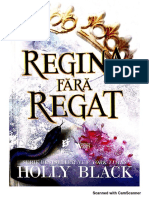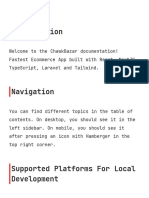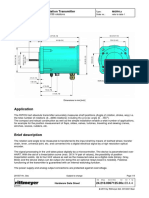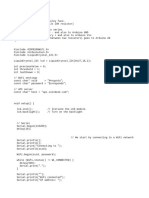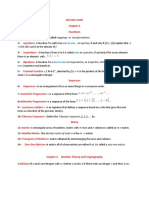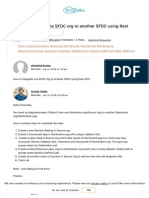0 ratings0% found this document useful (0 votes)
74 views9 pagesFlow Interview Question
Salesforce Flow is a tool for automating business processes, with various types including Screen Flow, Record-Triggered Flow, and Scheduled Flow. Flow Builder is the interface for creating flows, which can include elements like Decision, Assignment, and Sub-flow, and can handle errors through Fault Paths. Best practices for using flows include testing, avoiding DML in loops, and leveraging before-save flows for updates.
Uploaded by
ketansf111Copyright
© © All Rights Reserved
We take content rights seriously. If you suspect this is your content, claim it here.
Available Formats
Download as PDF, TXT or read online on Scribd
0 ratings0% found this document useful (0 votes)
74 views9 pagesFlow Interview Question
Salesforce Flow is a tool for automating business processes, with various types including Screen Flow, Record-Triggered Flow, and Scheduled Flow. Flow Builder is the interface for creating flows, which can include elements like Decision, Assignment, and Sub-flow, and can handle errors through Fault Paths. Best practices for using flows include testing, avoiding DML in loops, and leveraging before-save flows for updates.
Uploaded by
ketansf111Copyright
© © All Rights Reserved
We take content rights seriously. If you suspect this is your content, claim it here.
Available Formats
Download as PDF, TXT or read online on Scribd
You are on page 1/ 9
Q)What is flow
=>A flow in Salesforce is a tool that automates business
processes. Flows collect data and perform tasks with that data.
Q)What are the types of flow?
=>
1. Screen Flow:In Salesforce, a screen flow is a type of flow
that guides users through a business process.
2. record triggered flow :record triggered flow use whenever
we want to update,insert,create,delete operation,,this auto-
launched flow run in background
3. Scheduled triggered flow::launched at specified time for
each record in batch,this auto-launch flow also run in
background.
4. Platform event : flow-launched when platform event
message is received,this auto-launch flow also run in
background
5. Auto-launch flow: auto-launch flow invoked apex,rest
API,process and more
Q) What is Flow Builder?
=>flow builder is declarative user interface used to build flows.
Q)How are Separate Screen Flows different from Auto
launched Flows?
=>Screen Flows are designed to interact with users. They can
display information, collect user data through screens, and
guide users through steps. Auto-launched Flows, on the other
hand, are designed to run in the background without any user
interaction, typically triggered by an event like a record
creation or update.
Q)What is the difference between a Record-Triggered
Flow and a Scheduled Flow?
=>A Record-Triggered Flow is initiated when a specific event
related to a record occurs, like when a record is created,
updated, or deleted. On the other hand, a Scheduled Flow
runs at specified intervals (e.g., daily, weekly) and operates on
records that meet the defined criteria.
Explain the “Decision” element in Salesforce Flow.
=>The “Decision” element in Salesforce Flow branches the
logic based on certain criteria. It evaluates multiple conditions
and directs the flow’s execution path depending on which
conditions are met. It’s similar to the “if-else” logic in
programming.
Can you call an Apex class from a Flow?
=>You can call an Apex class from a Flow using the “Apex”
action element. This enables you to use unique Apex logic to
increase the usefulness of Flows
Can Flows replace Apex Triggers?
=>While Flows can handle many automation scenarios
traditionally managed by Apex Triggers, they can only partially
replace them. Apex Triggers are more flexible and can handle
more complex scenarios, especially those involving deep
integration, complex calculations, or operations outside the
Salesforce platform. However, using Flows for declarative
automation can reduce code and improve maintainability.
Q)How can you handle errors in a Flow?
=>You can handle errors in Flows using Fault Paths. When an
error occurs in a Flow element, the Flow can be directed to a
Fault Path, where you can define how the error should be
handled, such as sending an email notification, creating a log
record, or displaying a custom error message to the user.
Q) What are Fast Lookup and Fast Create in Flows?
=>Fast Lookup: A s Object collection variable can be used to
obtain numerous records at once and store them there.
Fast Create: This allows you to create multiple records at once
using a s Object collection variable.
Q)How do Before-Save Record-Triggered Flows differ
from After-Save Record-Triggered Flows?
=> Before a record is saved to the database, Before-Save
Record-Triggered Flows are initiated. This means they can
modify the record without needing an additional DML
operation. They are more efficient for this reason. After-Save
Record-Triggered Flows run after the record is saved and are
suitable for actions that should happen post-record save, such
as sending notifications or creating related records.
17. How can you optimize the performance of a Flow?
=>
• Minimizing the number of elements and unnecessary
logic.
• Efficiently using loops and avoiding nested loops.
• Leveraging Fast Lookup and Fast Create for bulk
operations.
• Avoiding hard-coded IDs or values and using variables and
formulas instead.
• Testing the Flow thoroughly in bulk scenarios ensures it
doesn’t hit governor limits.
Q)what are flow resources?
=>
1) action
2) decision outcome
3) Constant
4) Formula
5) Global Constant
6) Screen component
7) Variable
Q) What are key Building block of flow?
=>
1)Element
2) connectors
3) Resources
Q)What is flow interview
=>is a running instance of flow,you can run flow interview
through link,button,or tab
1) pause flow a interview
2) Resume a flow interview
3) Delete a Flow interview
Q)explain some of flow elements?
=>
1)Screen
2)Action
3)Sub-flow
4)assignment
5)Decision
6)Loop
7)Collection Sort
8)Collection Filter
9)Create Record
10)Update Record
11)Get record
Q)What is the role of the “Assignment” element in
Flows?
=>The “Assignment” element assigns values to variables or
sObject fields within the Flow. This can be used for calculations,
data transformations, or setting values before creating or
updating records
Q)How can you can call flow from Quick Action?
=>
) Go to Object Management Settings for Accounts
) Select Buttons, Links, and Actions
) Click New Action
) Select Flow for Action Type
) Choose a flow to use as a quick action
) Save your work
Q)How can you debug a Flow?
Answer: Salesforce provides a debug tool within Flow Builder.
You can run the Flow in debug mode, set input variable values,
and step through the Flow’s execution. The debug logs and the
Flow’s interview logs can also provide insights into any issues.
Q)What is flow Orchestra-tor?
=>The Flow Orchestra-tor is a tool that lets you orchestrate
multi-user, multi-step, and multi-stage flows.
Q)What is a Sub-flow?
=> A Sub-flow is another Flow from within a main Flow. It
allows for modular design, where you can create reusable
components and logic by encapsulating them into separate
Flows and invoking them as Sub-flows.
Q)What are Salesforce flow best practices?
=>
• Plan before building
• Test your flows
• Use sub-flows
• Avoid DML statements in loops
• Avoid hard coding values
• Utilize entry criteria
• Leverage record-triggered flows
• Plan for faults
• Use before-save flows for same record updates
• Build in a test/sandbox environment
Q)what is Salesforce flow trigger explorer?
=>Salesforce Flow Trigger Explorer is a feature that allows
users to view the order in which record-triggered flows run
against a specific object.
Q)how can you troubleshoot Salesforce flows?
1) Debug on canvas: This is the most common method for
debugging flows. It's available for all flow types except Platform
Event Triggered.
2) Debug as another user: In Flow Builder, select the Debug
button, then check the Run flow as another user checkbox.
3) Create a fault path: Add a fault connector to the flow element
that might cause an error. Then connect the fault connector to
a new flow element that handles the error.
4) Check variables: Review all the variables and make sure they're
configured correctly.
5) Check debug logs: In the developer console, check the debug
logs for more details.
Q)What is Auto-layout in Salesforce?
=>Auto-layout in Salesforce is a beta feature that automatically
spaces, connects, and aligns elements on a canvas.
Q)Can schedule triggered flow make a call-out?
=>
Yes, a schedule-triggered flow can make call-outs after
executing a Pause element. Without a Pause element, the
flow can't access external objects, execute Apex actions that
make call-outs, or execute actions that are generated from
External Services registrations.
Q)can we use Lightning component in flow?
=>Yes
Q)How call a flow into another flow?
=>sub flow element
Screen flow can call another Screen flow as a sub Flow
Record triggered flow can call another auto-launched
flow as sub flow.
Q)Some Action that can be done through flow?
=>1)post to chatter
2) send email
3) Send notification
4) Call sub flow
5) Call apex class
6) Call approval process
Q) Fast field Update VS Action& Related records
=>
Fast Field update: update fields on record that trigger the flow
to run,in this case flow runs before the record is saved to the
database.
Action& Related records: Update any records and perform
action like swnding email alert,in this case flow runs after the
record is saved into the datbase.
Q) call records be shared with users through flow?
=>yes
Ex.if you want shared account records so in flow you can
create a record of account Share object.
Q)Can we set ordered of execution of record triggered
flow
=>yes,through flow trigger explorer
Q) Can we debug a flow as another user?
=>yes,we need to enable the setting from process automation
settings.
Q)IF INTERVIWER ASKED HOW DO YOU HANDLED
ERRORS IN FLOW?
=>Error in flow can be managed using fault paths,by creating
paths for Potential error and specify action to take such as
displaying custom error message.
Q) What is difference between Screen flow and
Autolauched flow ?
=>Screen Flow:
1)interact with users by presenting screen for input
2)Screen flow are user driven
Autolauched flow :
1) AUTOLAUCH flow runs in background without user
Interaction,
2) Autolauched flow are typically triggred by record changes
or api calls
Q)What is Dynamic record Choice ?
=>Dynamic record choice in a flow allows for flexible record
selection based on criteria,it dynamically Queries records and
the choices presented to user depend on the runtime data.
Q)What is record-lookup element in a Salesforce
flow,and how does differ from fast lookup element?
=>Record lookup element used to retrieved a single record
based on specified criteria in Flow,It differ from the Fast
Lookup element by allowing the Quickly Querying Single
record the database based on specified criteria.
Q)ARE all flows supported in all editions of flows?
=>no flows are not supported in all editions in flows, flows are
only available in following edition, Enterprise ,performance
and unimited.
Q) Best practices of Flows?
=>
1)always test your flows
3) Consider using sub-flows
4) Never perform DML Statement in loops
5) Never use hard coded ids
6) Always use before save flows for same record update
Q)What are the limitations of using Salesforce Flow?
=>
) Limited loop count (like 2000 iterations)
) A limited number of SOQL queries and DML statements
per flow execution
) Some complex operations might still require Apex code
) Flows can’t be used in certain scenarios where triggers
are required
You might also like
- Data Structure and Algorithms Unit 4 Linked List100% (4)Data Structure and Algorithms Unit 4 Linked List54 pages
- TC3097en-Ed02_Release_Note_for_Alcatel-Lucent_Enterprise_Myriad_and_Halo_series_R140No ratings yetTC3097en-Ed02_Release_Note_for_Alcatel-Lucent_Enterprise_Myriad_and_Halo_series_R14037 pages
- Seismic Visualisation Using Python Language - 240405 - 120657No ratings yetSeismic Visualisation Using Python Language - 240405 - 12065728 pages
- Firewalls Design Principles, Estimated SystemsNo ratings yetFirewalls Design Principles, Estimated Systems21 pages
- 11 22 1081 01 0wng Overview of 802 15 4ab CoexistenceNo ratings yet11 22 1081 01 0wng Overview of 802 15 4ab Coexistence15 pages
- Professional Process Improvement Plan InfographicsNo ratings yetProfessional Process Improvement Plan Infographics5 pages
- Intime Global Your Apple Repair Partner in UAENo ratings yetIntime Global Your Apple Repair Partner in UAE7 pages
- Cryptocurrency Price Prediction Using LSTM and GRU NetworksNo ratings yetCryptocurrency Price Prediction Using LSTM and GRU Networks4 pages
- Entity Relationship Diagram. Design Element — Crows Foot _ Entity Relationship Diagram Symbols and Meaning. ERD Symbols _ ER Diagram Tool _ Crows Foot Notation Examples PdfNo ratings yetEntity Relationship Diagram. Design Element — Crows Foot _ Entity Relationship Diagram Symbols and Meaning. ERD Symbols _ ER Diagram Tool _ Crows Foot Notation Examples Pdf17 pages
- UNIT IV CONTEXT FREE GRAMMARS and LANGUAGESNo ratings yetUNIT IV CONTEXT FREE GRAMMARS and LANGUAGES69 pages
- RIPOS Hart Absolute Rotation TransmitterNo ratings yetRIPOS Hart Absolute Rotation Transmitter9 pages
- Salesforce Lightning Setup for EZACD-8000No ratings yetSalesforce Lightning Setup for EZACD-800015 pages
- In_Depth_Interview_Question_on_Schedulable_Apex__1713343567No ratings yetIn_Depth_Interview_Question_on_Schedulable_Apex__171334356724 pages
- Interview Questions Salesforce by Ashish SirNo ratings yetInterview Questions Salesforce by Ashish Sir8 pages
- HTML5 e CSS3 - Guia Prático e Visual (7 Edição) (009-010)No ratings yetHTML5 e CSS3 - Guia Prático e Visual (7 Edição) (009-010)2 pages
- Salesforce CRM Administration Handbook: A comprehensive guide to administering, configuring, and customizing Salesforce CRMFrom EverandSalesforce CRM Administration Handbook: A comprehensive guide to administering, configuring, and customizing Salesforce CRMNo ratings yet
- Lightning Web Components Interview Guide- By RiteshNo ratings yetLightning Web Components Interview Guide- By Ritesh12 pages
- Write SOQL Queries Unit - Salesforce TrailheadNo ratings yetWrite SOQL Queries Unit - Salesforce Trailhead7 pages
- Supercharge Your Salesforce Path- Interview Pro Edition_System Design and ArchitectureNo ratings yetSupercharge Your Salesforce Path- Interview Pro Edition_System Design and Architecture13 pages
- Prepared Hard Still Not Enough ? 1750506333No ratings yetPrepared Hard Still Not Enough ? 175050633310 pages
- 20 Common Errors in Salesforce With Resolution 1720015105No ratings yet20 Common Errors in Salesforce With Resolution 172001510512 pages
- LWC Salesforce trending scenario Interview Questions 3+YOENo ratings yetLWC Salesforce trending scenario Interview Questions 3+YOE11 pages
- How To Integrate One SFDC Org To Another SFDC Using Rest API - Salesforce® Discussions - ForcetalksNo ratings yetHow To Integrate One SFDC Org To Another SFDC Using Rest API - Salesforce® Discussions - Forcetalks5 pages
- Salesforce Integration Interview Questions and AnswersNo ratings yetSalesforce Integration Interview Questions and Answers4 pages
- Sharing and Visibility Designer - 46 Links of Success (By 0to1code - Com)No ratings yetSharing and Visibility Designer - 46 Links of Success (By 0to1code - Com)14 pages
- Ultimate Salesforce LWC Developers’ Handbook: Build Dynamic Experiences, Custom User Interfaces, and Interact with Salesforce data using Lightning Web Components (LWC) for Salesforce Cloud (English Edition)From EverandUltimate Salesforce LWC Developers’ Handbook: Build Dynamic Experiences, Custom User Interfaces, and Interact with Salesforce data using Lightning Web Components (LWC) for Salesforce Cloud (English Edition)No ratings yet
- Salesforce Dreamforce 2012 - Docusign Apex REST API IntegerationNo ratings yetSalesforce Dreamforce 2012 - Docusign Apex REST API Integeration14 pages




